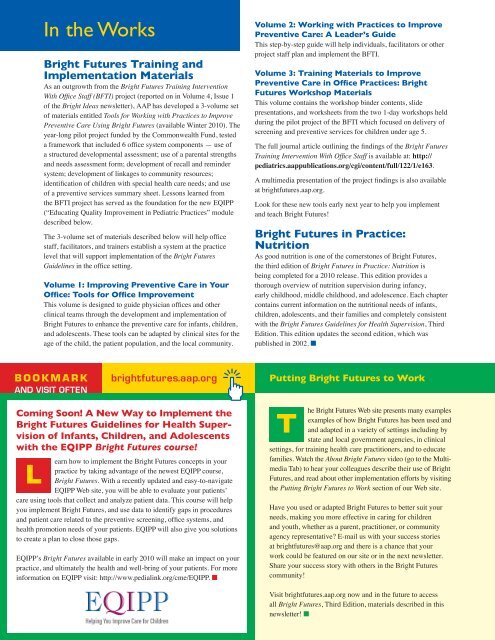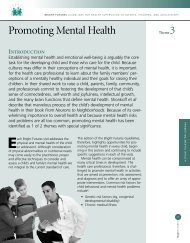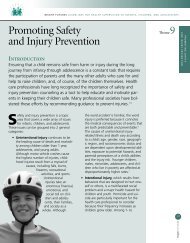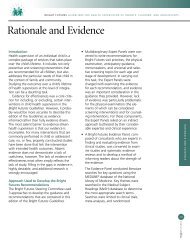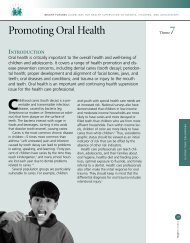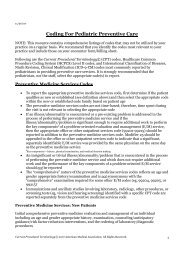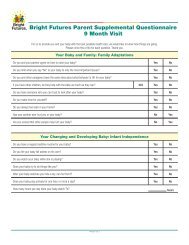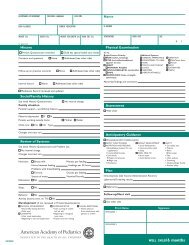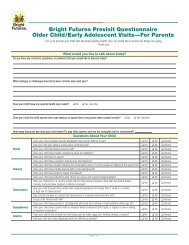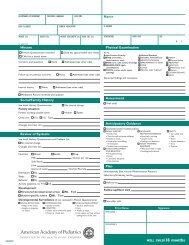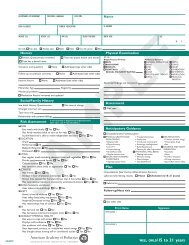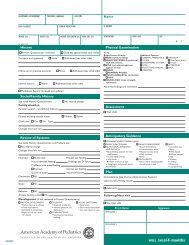New Tools Make Using Bright Futures Guidelines Easier
New Tools Make Using Bright Futures Guidelines Easier
New Tools Make Using Bright Futures Guidelines Easier
You also want an ePaper? Increase the reach of your titles
YUMPU automatically turns print PDFs into web optimized ePapers that Google loves.
L<br />
In the Works<br />
<strong>Bright</strong> <strong>Futures</strong> Training and<br />
Implementation Materials<br />
As an outgrowth from the <strong>Bright</strong> <strong>Futures</strong> Training Intervention<br />
With Office Staff (BFTI) project (reported on in Volume 4, Issue 1<br />
of the <strong>Bright</strong> Ideas newsletter), AAP has developed a 3-volume set<br />
of materials entitled <strong>Tools</strong> for Working with Practices to Improve<br />
Preventive Care <strong>Using</strong> <strong>Bright</strong> <strong>Futures</strong> (available Winter 2010). The<br />
year-long pilot project funded by the Commonwealth Fund, tested<br />
a framework that included 6 office system components — use of<br />
a structured developmental assessment; use of a parental strengths<br />
and needs assessment form; development of recall and reminder<br />
system; development of linkages to community resources;<br />
identification of children with special health care needs; and use<br />
of a preventive services summary sheet. Lessons learned from<br />
the BFTI project has served as the foundation for the new EQIPP<br />
(“Educating Quality Improvement in Pediatric Practices” module<br />
described below.<br />
The 3-volume set of materials described below will help office<br />
staff, facilitators, and trainers establish a system at the practice<br />
level that will support implementation of the <strong>Bright</strong> <strong>Futures</strong><br />
<strong>Guidelines</strong> in the office setting.<br />
Volume 1: Improving Preventive Care in Your<br />
Office: <strong>Tools</strong> for Office Improvement<br />
This volume is designed to guide physician offices and other<br />
clinical teams through the development and implementation of<br />
<strong>Bright</strong> <strong>Futures</strong> to enhance the preventive care for infants, children,<br />
and adolescents. These tools can be adapted by clinical sites for the<br />
age of the child, the patient population, and the local community.<br />
B o o k m a r k<br />
and visit often<br />
brightfutures.aap.org<br />
Coming Soon! A <strong>New</strong> Way to Implement the<br />
<strong>Bright</strong> <strong>Futures</strong> <strong>Guidelines</strong> for Health Supervision<br />
of Infants, Children, and Adolescents<br />
with the EQIPP <strong>Bright</strong> <strong>Futures</strong> course!<br />
earn how to implement the <strong>Bright</strong> <strong>Futures</strong> concepts in your<br />
practice by taking advantage of the newest EQIPP course,<br />
<strong>Bright</strong> <strong>Futures</strong>. With a recently updated and easy-to-navigate<br />
EQIPP Web site, you will be able to evaluate your patients’<br />
care using tools that collect and analyze patient data. This course will help<br />
you implement <strong>Bright</strong> <strong>Futures</strong>, and use data to identify gaps in procedures<br />
and patient care related to the preventive screening, office systems, and<br />
health promotion needs of your patients. EQIPP will also give you solutions<br />
to create a plan to close those gaps.<br />
EQIPP’s <strong>Bright</strong> <strong>Futures</strong> available in early 2010 will make an impact on your<br />
practice, and ultimately the health and well-bring of your patients. For more<br />
information on EQIPP visit: http://www.pedialink.org/cme/EQIPP. ■<br />
Volume 2: Working with Practices to Improve<br />
Preventive Care: A Leader’s Guide<br />
This step-by-step guide will help individuals, facilitators or other<br />
project staff plan and implement the BFTI.<br />
Volume 3: Training Materials to Improve<br />
Preventive Care in Office Practices: <strong>Bright</strong><br />
<strong>Futures</strong> Workshop Materials<br />
This volume contains the workshop binder contents, slide<br />
presentations, and worksheets from the two 1-day workshops held<br />
during the pilot project of the BFTI which focused on delivery of<br />
screening and preventive services for children under age 5.<br />
The full journal article outlining the findings of the <strong>Bright</strong> <strong>Futures</strong><br />
Training Intervention With Office Staff is available at: http://<br />
pediatrics.aappublications.org/cgi/content/full/122/1/e163.<br />
A multimedia presentation of the project findings is also available<br />
at brightfutures.aap.org.<br />
Look for these new tools early next year to help you implement<br />
and teach <strong>Bright</strong> <strong>Futures</strong>!<br />
<strong>Bright</strong> <strong>Futures</strong> in Practice:<br />
Nutrition<br />
As good nutrition is one of the cornerstones of <strong>Bright</strong> <strong>Futures</strong>,<br />
the third edition of <strong>Bright</strong> <strong>Futures</strong> in Practice: Nutrition is<br />
being completed for a 2010 release. This edition provides a<br />
thorough overview of nutrition supervision during infancy,<br />
early childhood, middle childhood, and adolescence. Each chapter<br />
contains current information on the nutritional needs of infants,<br />
children, adolescents, and their families and completely consistent<br />
with the <strong>Bright</strong> <strong>Futures</strong> <strong>Guidelines</strong> for Health Supervision, Third<br />
Edition. This edition updates the second edition, which was<br />
published in 2002. ■<br />
Putting <strong>Bright</strong> <strong>Futures</strong> to Work<br />
T<br />
he <strong>Bright</strong> <strong>Futures</strong> Web site presents many examples<br />
examples of how <strong>Bright</strong> <strong>Futures</strong> has been used and<br />
and adapted in a variety of settings including by<br />
state and local government agencies, in clinical<br />
settings, for training health care practitioners, and to educate<br />
families. Watch the About <strong>Bright</strong> <strong>Futures</strong> video (go to the Multimedia<br />
Tab) to hear your colleagues describe their use of <strong>Bright</strong><br />
<strong>Futures</strong>, and read about other implementation efforts by visiting<br />
the Putting <strong>Bright</strong> <strong>Futures</strong> to Work section of our Web site.<br />
Have you used or adapted <strong>Bright</strong> <strong>Futures</strong> to better suit your<br />
needs, making you more effective in caring for children<br />
and youth, whether as a parent, practitioner, or community<br />
agency representative? E-mail us with your success stories<br />
at brightfutures@aap.org and there is a chance that your<br />
work could be featured on our site or in the next newsletter.<br />
Share your success story with others in the <strong>Bright</strong> <strong>Futures</strong><br />
community!<br />
Visit brightfutures.aap.org now and in the future to access<br />
all <strong>Bright</strong> <strong>Futures</strong>, Third Edition, materials described in this<br />
newsletter! ■


